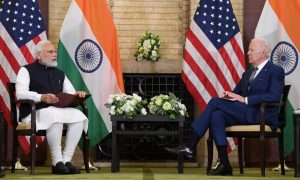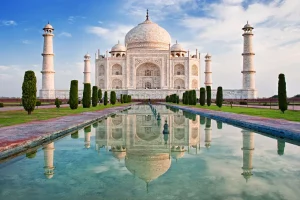The Taj Mahal, which was constructed in 1632 by Emperor Shah Jahan in memory of his wife Mumtaz Mahal, had been initially named ‘Roza-e-Munavvara’ which means Unique Building.
HIGHLIGHTS
- The Taj Mahal was constructed in 1632 by Shah Jahan in memory of his wife Mumtaz Mahal
- It was initially named ‘Roza-e-Munavvara’ which means Unique Building
- Later, it was renamed by Shah Jahan as Taj Mahal as a loving tribute to his wife
The Taj Mahal, which was constructed in 1632 by Emperor Shah Jahan in memory of his wife Mumtaz Mahal, had been initially named ‘Roza-e-Munavvara’ which means Unique Building, but was then renamed by Shah Jahan as Taj Mahal as a loving tribute to his wife for whom his love surpassed all belief.
A total of 40 thousand labourers and artisans worked on it continuously for twenty years, the culmination of their work now known as one of the Seven Wonders of the World and a dream for every loving couple in the world. Despite the fact that there are thousands of monuments in the world that are contemporary to the Taj Mahal and even centuries older, the Taj is thronged by thousands of tourists every day from across the globe, who all come to see this monument, which is known as an epitome of love.
STORY BEHIND THE TAJ MAHAL
How the construction of the Taj Mahal started, has been well-documented by several historians and they all agree that the Taj was constructed when Shah Jahan’s most beloved wife Arzumand Banu Begum, popularly known as Mumtaz Mahal, died giving birth to her 14th child near Burhanpur in Madhya Pradesh where she had been accompanying Shah Jahan on one of his military campaigns. Mumtaz died at the age of 39.
Shah Jahan was so distraught upon Mumtaz’s death that he confined himself in a room for a week and when he came out of the room, all his hair had turned grey. Mumtaz’s body was interred temporarily in Burhanpur itself and was later on transferred to the Taj Mahal’s central hall.
Historians believe that there is ample evidence to prove that the land on which the Taj Mahal has been constructed, belonged to Raja Jai Singh and there was an orchard on this land, which was removed to build the Taj Mahal. Jai Singh was compensated for the land in the form of 5 ‘Havelis’ as the tomb for Mumtaz Mahal could not be constructed on donated land according to Islamic tenets.
THE DESIGN
The Taj had been designed by Ustad Ahmad Lahori and Ustad Abdul Karim, which was approved by Shah Jahan. The Taj took over two decades to be constructed and there were artisans called from as far as Armenia, Italy, France, and Turkey working on the monument. Over 39 types of semi-precious stones were used in this monument along with 4000-kg of gold. Consequently, by the time Taj Mahal was constructed, the empire was in serious trouble due to lack of funds. With the Marathas and the Rajputs encroaching into the empire’s boundaries and Shah Jahan lost in his own reveries, his son Muhi-ud-Din Mohammad, took charge of the empire’s armies and suppressed the rebellions, later on returning to Agra to imprison his own father and murder his brothers to name himself as the sixth Mughal emperor Aurangzeb. Shah Jahan’s last days were spent confined in his room in the Agra Fort, gazing from across the Yamuna at the Taj Mahal.
Bhartiya Muslim Vikas Parishad chairman Sami Aghai told India Today that the Taj Mahal is an amalgam of Indo-Persian architecture, which is reflected in the numerous murals and reliefs of the holy Indian flower Lotus adorning the marble walls of the monument. Even on the pinnacle, the Islamic Moon is combined with the Hindu ‘Mangal Kalash’ on which the word ‘Allah’ has been carved.
TAJ DECLARED WORLD HERITAGE BUILDING
The Taj was declared World Heritage building in 1983. American novelist Baird Taylor once said that if India had no other monuments, even then the Taj Mahal would have attracted the entire world with its beauty.
Approved Guides Association President Shamshuddin told India Today that political leaders and heads of state from all over the world come to Agra solely to see the Taj Mahal. British military officer Colonel Sloman’s wife had famously once said, “if someone can build a majestic tomb like the Taj Mahal for me, I would die tomorrow.” Former US President Bill Clinton had said that there are two kinds of people in the world, one who have seen the Taj Mahal and one who hasn’t.
Till the 1960s, the Taj Mahal used to open 24 hours and there was no ticket for the monument. Thousands of people from all over India came to the Taj during moonlit nights to see the ‘chamki’ phenomenon in which the Taj Mahal’s stones glittered like diamonds of viewed at the correct angle under the moonlight.
Now, the Taj is one of the most heavily ticketed monuments in the country and is only open for five moonlit nights every month for a restricted group of 400 tourists in batches of 50. The river Yamuna, which had once been the primary reason of building the Taj Mahal on this location, has dried up almost completely and does not have enough water year round to quench the thirst of even one-third of the city’s population. Agra, a city which was once the capital of Mughal India, has now been reduced to a Class-C township which survives almost entirely on the tourism generated by the Taj Mahal and the other Mughal monuments dotting its landscape.













